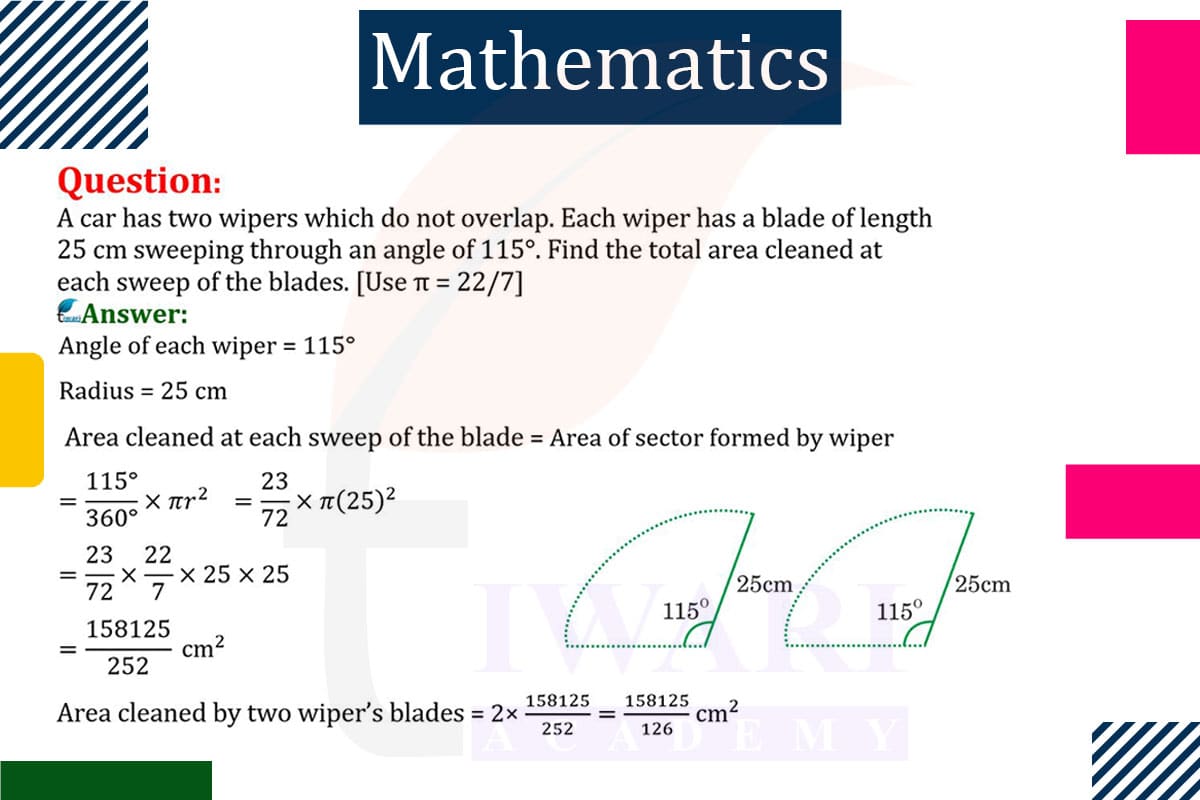Area Cleaned by One Wiper: Each wiper blade is 25 cm long and sweeps through an angle of 115°. The area cleaned by one wiper is a sector of a circle. The area of a sector is given by (θ/230)×πr², where θ is the angle in degrees and r is the radius (length of the wiper blade). For one wiper, the area is (115/360)×π×25² cm².
Total Area Cleaned: Since there are two wipers and they do not overlap, the total area cleaned is twice the area cleaned by one wiper. Therefore, the total area is 2×(115/360)×π×25² cm².
This calculation gives the total area cleaned by both wipers in each sweep.

Let’s discuss in detail
Introduction to the Geometry of Windshield Wipers
The problem of calculating the total area cleaned by the windshield wipers of a car is a practical application of geometry in everyday life. Windshield wipers are essential for maintaining visibility during adverse weather conditions. In this scenario, each wiper has a blade of length 25 cm and sweeps through an angle of 115°. Understanding how to calculate the area cleaned by these wipers not only illustrates the application of geometric principles but also helps in appreciating the design considerations that go into vehicle safety features.
The Mechanics of Windshield Wipers
Windshield wipers are designed to clear as much water or debris from the windshield as possible, ensuring clear visibility. Each wiper moves in an arc, covering a specific portion of the windshield. The blade length and the angle through which it sweeps determine the area it can clean. In this case, the wipers do not overlap, meaning each wiper operates independently within its own sector of the windshield. This non-overlapping aspect is crucial for calculating the total area cleaned.
Calculating the Area Cleaned by a Single Wiper
To calculate the area cleaned by one wiper, we consider the motion of the wiper as creating a sector of a circle on the windshield. The formula for the area of a sector is (θ/360)×πr², where θ is the angle of sweep and r is the radius, equivalent to the length of the wiper blade. For a wiper blade of 25 cm sweeping through an angle of 115°, the area cleaned by one wiper is (115/360)×π×25² square centimeters.
Total Area Cleaned by Both Wipers
Since the car has two wipers and they do not overlap, the total area cleaned is simply twice the area cleaned by one wiper. This is calculated by multiplying the area cleaned by one wiper by two. The total area cleaned by both wipers in each sweep is therefore
2×(115/360)×π×25² square centimeters. This calculation gives us a clear understanding of the effectiveness of the wipers in terms of the area they can cover.
Practical Implications in Car Design
The calculation of the area cleaned by windshield wipers has practical implications in car design. It helps in determining the required length and sweep angle of the wipers to ensure maximum coverage and efficiency. This is crucial for driver safety, especially in harsh weather conditions. The design must balance the size and motor strength of the wipers with the need for maximum visibility. Understanding the area each wiper covers aids in optimizing this balance.
Geometry in Everyday Technology
In conclusion, the problem of calculating the area cleaned by car windshield wipers is a perfect example of how geometry is applied in everyday technology. It demonstrates the importance of mathematical calculations in designing practical and efficient tools for daily use. This exercise not only enhances our understanding of geometric principles but also highlights the significance of mathematics in technological design and safety in the automotive industry. It’s a testament to the role of geometry in improving and safeguarding our daily lives.
Discuss this question in detail or visit to Class 10 Maths Chapter 11 for all questions.
Questions of 10th Maths Exercise 11.1 in Detail

